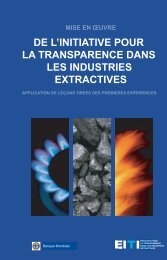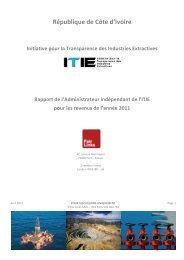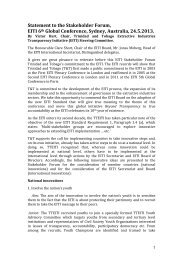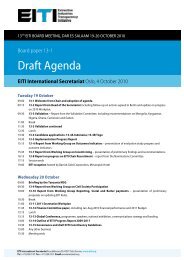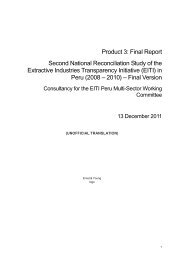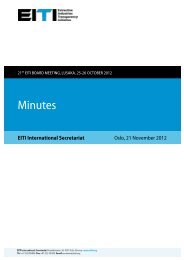Vietnam feasibility study - EITI
Vietnam feasibility study - EITI
Vietnam feasibility study - EITI
You also want an ePaper? Increase the reach of your titles
YUMPU automatically turns print PDFs into web optimized ePapers that Google loves.
18<br />
etc. The Nghi Son oil refinery complex and the Dung Quat refinery plan would satisfy about 50% of<br />
domestic consumption (PVN, 2011).<br />
environmental protection activities<br />
Mineral activities often cause negative impacts to the natural, social and built environment. Mining<br />
projects and mineral processing are required to produce an environmental impact assessment (EIA) or<br />
environmental commitments under the provisions of the Environmental Protection Law. Most current<br />
mining projects and mineral processing have an EIA report. However, the extended EIA is not carried<br />
out when the mining project expands its scale. Many minerals planning at both local and national scale<br />
issued by provincial and central authority (as planned exploration and processing bauxite, titanium,<br />
chromium, manganese, etc) have no reports of a Strategic Environmental Assessment. In general,<br />
environmental protection measures often do not reflect the content of the EIA report. Furthermore,<br />
the participation and engagement of civil society organizations and local communities in monitoring<br />
and overseeing in this process are still limited (CODE, 2010).<br />
Environmental rehabilitation activities based on the Decision No. 71/2008/QD-TTg issued by the<br />
Prime Minister in 2008 have not yet been implemented in many localities. Although exploitation<br />
activities are completed, environmental rehabilitation in many mining areas is not properly carried<br />
out. In most mining projects, the environmental protection fee is not fully collected because the<br />
extractive company often reports a lower production level to the governmental agencies when<br />
compared to the reality to evade a part of this fee. Moreover, the environmental protection fee is<br />
mainly used to mitigate environmentally adverse impacts derived from mining activities rather than<br />
to prevent or limit such impacts based on government regulations. Moreover, this fund is not fairly<br />
distributed sometimes. In some highly affected areas, the environmental protection is not considered<br />
a priority. Consequently, the mining activities in some areas have caused serious negative impacts to<br />
the environment, agriculture and local community’s life (CODE 2010).<br />
I.2.3 The contribution and influence of the extractive industry<br />
Contribution to social economic development<br />
Generally speaking, the extractive industry has played a crucial role in the national economy<br />
throughout decades. Regardless of oil and gas, the mining and quarrying industry accounted for 4.81%<br />
of GDP by 1995 and increased to around 9.5%-10.59% from 2000 to 2008 (USGS, 2010; GSO, 2009).<br />
Remarkably, revenue generated from crude oil only contributed 24.37% to state budget revenue in<br />
2008 (GSO, 2008). The extractive industry does not only contribute to the national income, but also<br />
brings in substantial foreign currency that helps to stabilize the national economy. By 2009, it brought<br />
in about 8.5 billion USD from export, of which crude oil was the major commodity with 6.2 billion USD.<br />
Furthermore, the mining sector creates a high number of jobs with 431,200 direct labors involved in it<br />
and accounting for 0.96% of the total country’s workforce (GSO, 2008).<br />
The initial contribution of the mining sector to national development is remarkable. However, the<br />
mining industry has also exposed some weak points:<br />
the position of mining sector in the national economy<br />
Economic efficiency is not commensurate with capital investment: the investment for mining sector<br />
is normally very high compared with total investment for the other sectors. However, the effective<br />
contribution to GDP growth (i.e., the ratio of the contribution of mining to GDP / total investment in<br />
mining) is not so high. For example, the total investment for the mining sector in the period of 2005-<br />
2008 is ranked at five of 18 sectors. Meanwhile, the contribution to the national economy is ranked at<br />
8 th compared to other economic sectors.<br />
The Extractive Industries Transparency Initiative and the Implementation Perspective of <strong>Vietnam</strong>




